Effectiveness of Animal Assisted Therapy on Children with Autism Spectrum Disorder
Investigating the impact of animal assisted therapy on the psychosocial outcome of children with Autism Spectrum Disorder (ASD)
56 Pages15221 Words221 Views
Added on 2022-10-06
About This Document
This systematic review examines the effectiveness of animal assisted therapy on the psychosocial outcome of children with autism spectrum disorder (ASD). The study design, inclusion and exclusion criteria, search procedures, data extraction, and analysis are discussed. The findings suggest that animal assisted therapy can improve communication, motor skills, challenging behavior, and quality of life in children with ASD.
Effectiveness of Animal Assisted Therapy on Children with Autism Spectrum Disorder
Investigating the impact of animal assisted therapy on the psychosocial outcome of children with Autism Spectrum Disorder (ASD)
Added on 2022-10-06
ShareRelated Documents
Running head: DISSERTATION
DISSERTATION:
THE EFFECTIVENESS OF ANIMAL ASSISTED THERAPY ON
THEIR PSYCHOSOCIAL OUTCOME OF CHILDREN WITH
AUTISM SPECTRUM DISORDER (ASD)
Name of the Student
Name of the University
Author Note
DISSERTATION:
THE EFFECTIVENESS OF ANIMAL ASSISTED THERAPY ON
THEIR PSYCHOSOCIAL OUTCOME OF CHILDREN WITH
AUTISM SPECTRUM DISORDER (ASD)
Name of the Student
Name of the University
Author Note
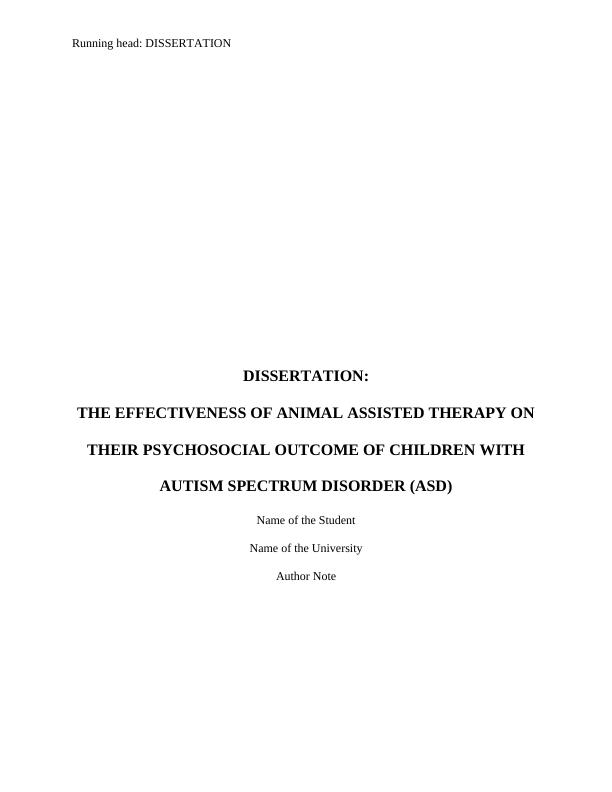
1DISSERTATION
Table of Contents
Chapter 2..........................................................................................................................................2
Methodology....................................................................................................................................2
2.1 Study Design (PICOS)...........................................................................................................2
2.2 Inclusion and exclusion criteria (PRISMA Chart).................................................................3
2.3 Search Procedures..................................................................................................................6
2.4 Data extraction.......................................................................................................................6
2.5 Data analysis..........................................................................................................................7
Chapter 3..........................................................................................................................................7
Systematic review findings..............................................................................................................7
3.1 Selection of studies................................................................................................................7
3.2 Risk of bias..........................................................................................................................12
3.3 Implementation of AAT for children with ASD..................................................................12
3.4 Outcomes of AAT for children with ASD...........................................................................21
3.4.1 Improve in communication...........................................................................................21
3.4.2 Improve in motor skills.................................................................................................22
3.4.3 Improve in challenging behaviour................................................................................23
3.4.4 Improve in quality of life (QOL)..................................................................................25
3.5 Data table.............................................................................................................................26
3.6 Quality assessment...............................................................................................................35
Table of Contents
Chapter 2..........................................................................................................................................2
Methodology....................................................................................................................................2
2.1 Study Design (PICOS)...........................................................................................................2
2.2 Inclusion and exclusion criteria (PRISMA Chart).................................................................3
2.3 Search Procedures..................................................................................................................6
2.4 Data extraction.......................................................................................................................6
2.5 Data analysis..........................................................................................................................7
Chapter 3..........................................................................................................................................7
Systematic review findings..............................................................................................................7
3.1 Selection of studies................................................................................................................7
3.2 Risk of bias..........................................................................................................................12
3.3 Implementation of AAT for children with ASD..................................................................12
3.4 Outcomes of AAT for children with ASD...........................................................................21
3.4.1 Improve in communication...........................................................................................21
3.4.2 Improve in motor skills.................................................................................................22
3.4.3 Improve in challenging behaviour................................................................................23
3.4.4 Improve in quality of life (QOL)..................................................................................25
3.5 Data table.............................................................................................................................26
3.6 Quality assessment...............................................................................................................35
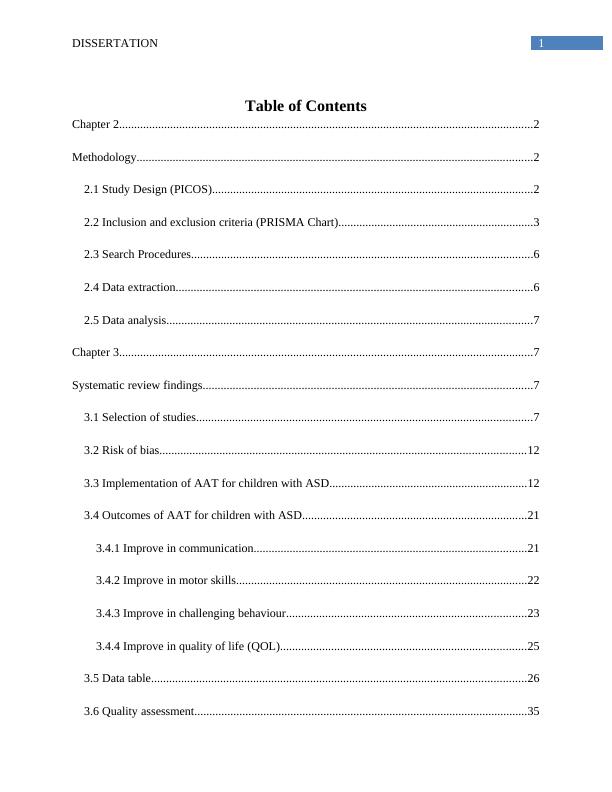
2DISSERTATION
Chapter 4........................................................................................................................................35
Discussions....................................................................................................................................35
4.1 Summarization of result.......................................................................................................35
4.2 Limitations...........................................................................................................................40
4.3 Results and recommendation to adapt the intervention in children with ASD....................41
4.4 Confounding factors............................................................................................................41
Chapter 5........................................................................................................................................42
Conclusion.....................................................................................................................................42
References......................................................................................................................................45
Appendices....................................................................................................................................52
Appendix 1.................................................................................................................................52
CONSORT 2010 Checklist....................................................................................................52
Chapter 4........................................................................................................................................35
Discussions....................................................................................................................................35
4.1 Summarization of result.......................................................................................................35
4.2 Limitations...........................................................................................................................40
4.3 Results and recommendation to adapt the intervention in children with ASD....................41
4.4 Confounding factors............................................................................................................41
Chapter 5........................................................................................................................................42
Conclusion.....................................................................................................................................42
References......................................................................................................................................45
Appendices....................................................................................................................................52
Appendix 1.................................................................................................................................52
CONSORT 2010 Checklist....................................................................................................52
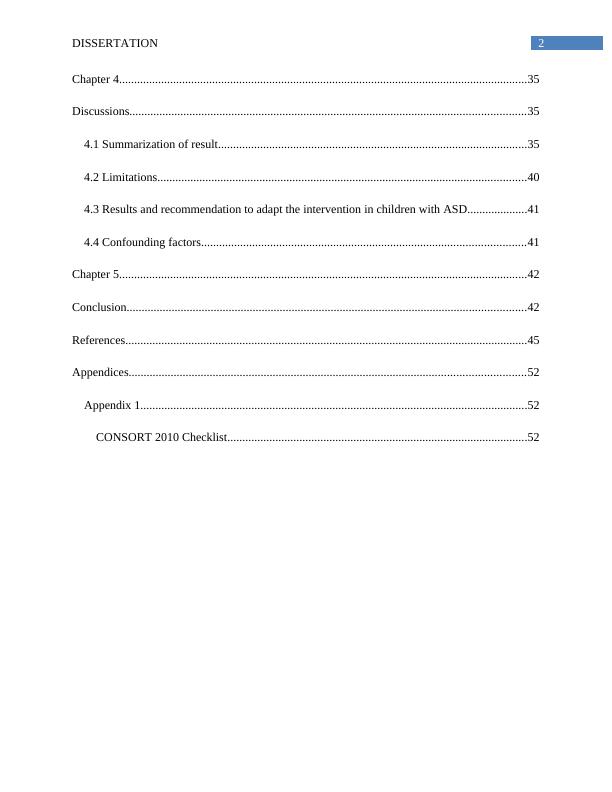
3DISSERTATION
Chapter 2
Methodology
2.1 Study Design (PICOS)
Systematic reviews are a key technique, supporting practice and informing decision-
making on healthcare (Moher et al., 2015). Conventionally systematic reviews are accomplished
using an objective and above all quantitative approach, by conducting an exhaustive search to
detect all appropriate papers that are then incorporated and assimilated by statistical analyses.
The integrity of the search was seen as an important factor in stopping misrepresentation and
offering a real representation of studies accessible. Therefore, current study on the method of
systematic qualitative examinations focuses on techniques to ensure as extensive and preliminary
searches as possible (Finnerup et al., 2015). Due to the time and resources needed for a
systematic and through search the sensitivity of surveys has been investigated and therefore the
time invested in examining irrelevant papers has been reduced with no advantage. The basis for
qualitative or narrative review, now widely known as syntheses of qualitative evidence, is
nevertheless also extensive research. Qualitative information synthesis is now recognized as a
precious and essential form of data to respond to the study issues of health facilities. However,
problems have been earlier observed in completing a delicate yet thorough search for qualitative
literature, such as: weak indexing and the use of main words in qualitative studies, prevalent
application of titles lacking the keywords describing this article and unorganized abstracts.
A search tool serves as an organizational framework for the preparation of a search
strategy to list terms of the major concepts in the search, particularly in teams where an
experienced information expert cannot become part of the review team. The PICO instrument
focuses on a (normally quantitative) article's population, intervention and comparison results. It
is frequently used to define clinical proof in evidence-based medicine for systematic reviews and
Chapter 2
Methodology
2.1 Study Design (PICOS)
Systematic reviews are a key technique, supporting practice and informing decision-
making on healthcare (Moher et al., 2015). Conventionally systematic reviews are accomplished
using an objective and above all quantitative approach, by conducting an exhaustive search to
detect all appropriate papers that are then incorporated and assimilated by statistical analyses.
The integrity of the search was seen as an important factor in stopping misrepresentation and
offering a real representation of studies accessible. Therefore, current study on the method of
systematic qualitative examinations focuses on techniques to ensure as extensive and preliminary
searches as possible (Finnerup et al., 2015). Due to the time and resources needed for a
systematic and through search the sensitivity of surveys has been investigated and therefore the
time invested in examining irrelevant papers has been reduced with no advantage. The basis for
qualitative or narrative review, now widely known as syntheses of qualitative evidence, is
nevertheless also extensive research. Qualitative information synthesis is now recognized as a
precious and essential form of data to respond to the study issues of health facilities. However,
problems have been earlier observed in completing a delicate yet thorough search for qualitative
literature, such as: weak indexing and the use of main words in qualitative studies, prevalent
application of titles lacking the keywords describing this article and unorganized abstracts.
A search tool serves as an organizational framework for the preparation of a search
strategy to list terms of the major concepts in the search, particularly in teams where an
experienced information expert cannot become part of the review team. The PICO instrument
focuses on a (normally quantitative) article's population, intervention and comparison results. It
is frequently used to define clinical proof in evidence-based medicine for systematic reviews and

4DISSERTATION
is supported by the Cochrane cooperation. Because of the basis in the target literature, several of
these search terms, such as "control group," and "intervention," are not applicable to qualitative
studies which does not traditionally use control groups or interventions. These conditions can,
however, become more important in the future, as further studies and interventions include
qualitative research. Since the PICO tool doesn't fulfil qualitative study or particular qualitative
design terms at present, it has in practice often been changed to "PICOS," whereas "S" refers to
the study design and thus limits the number of articles irrelevant (Shamseer et al., 2015).
2.2 Inclusion and exclusion criteria (PRISMA Chart)
If they are written in English and switch studies with compliance as a measured outcome,
original research papers have been entered. Study results had to be reviewed by peers and the full
text had to be accessible through the search portal. Studies that focus on anon-generalized
population were also excluded. While these surveys are important study items, they are excluded
in order to decrease the danger of external variables or access to drugs affecting the outcomes
owing to the demographic features of a research issue. Although quantitative studies have
historically been recognized as the gold standard of health research in order to generalize
outcomes to broader populations, it is essential that nursing practice is based on qualitative
variables such as situational variables and mature influences to develop formulations of plans of
care (Sinnott et al., 2016). Therefore, qualitative trials are included in this systematic review that
provides useful insights into patient preferences and experiences. In order to identify the
appropriate studies to be included in the study research, 178 papers have been tested and
evaluated through title and abstract scanning. The 21 items recognized as having prospective
significance through this technique of screening were then evaluated by retrieving a complete
text and evaluating the inclusion and exclusion criteria. In the excluded study table with a reason
is supported by the Cochrane cooperation. Because of the basis in the target literature, several of
these search terms, such as "control group," and "intervention," are not applicable to qualitative
studies which does not traditionally use control groups or interventions. These conditions can,
however, become more important in the future, as further studies and interventions include
qualitative research. Since the PICO tool doesn't fulfil qualitative study or particular qualitative
design terms at present, it has in practice often been changed to "PICOS," whereas "S" refers to
the study design and thus limits the number of articles irrelevant (Shamseer et al., 2015).
2.2 Inclusion and exclusion criteria (PRISMA Chart)
If they are written in English and switch studies with compliance as a measured outcome,
original research papers have been entered. Study results had to be reviewed by peers and the full
text had to be accessible through the search portal. Studies that focus on anon-generalized
population were also excluded. While these surveys are important study items, they are excluded
in order to decrease the danger of external variables or access to drugs affecting the outcomes
owing to the demographic features of a research issue. Although quantitative studies have
historically been recognized as the gold standard of health research in order to generalize
outcomes to broader populations, it is essential that nursing practice is based on qualitative
variables such as situational variables and mature influences to develop formulations of plans of
care (Sinnott et al., 2016). Therefore, qualitative trials are included in this systematic review that
provides useful insights into patient preferences and experiences. In order to identify the
appropriate studies to be included in the study research, 178 papers have been tested and
evaluated through title and abstract scanning. The 21 items recognized as having prospective
significance through this technique of screening were then evaluated by retrieving a complete
text and evaluating the inclusion and exclusion criteria. In the excluded study table with a reason
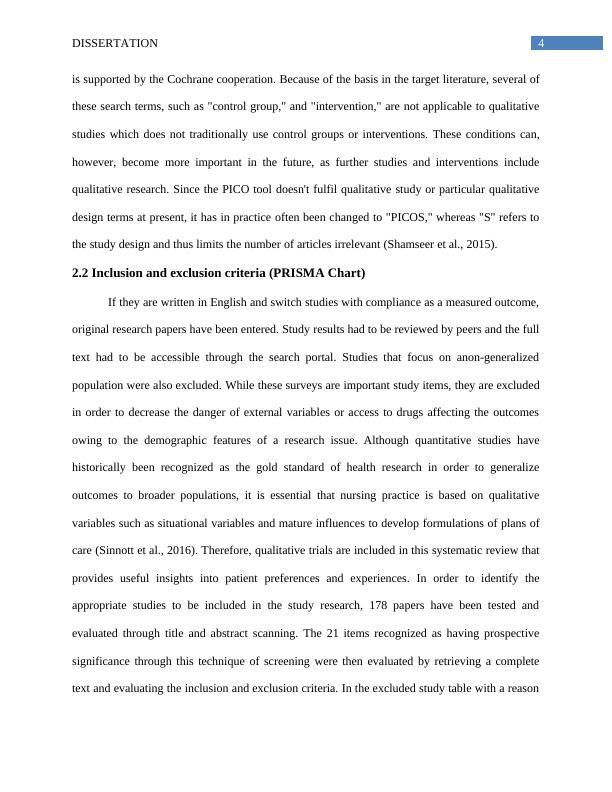
5DISSERTATION
for exclusion, the eleven papers excluded from this study at this point were recorded. Ten studies
have been recognized as appropriate and included in the study. The included studies examined
the experiences, opinions, attitudes and perceptions of nurses in the field of health care facilities.
Searches were not subject to any date limitation as this was an initial review. Qualitative research
has been described as using both a qualitative information collection technique and qualitative
analysis in the Cochrane Qualitative Methods Group. Consequently, quantitative and blended
methodology studies were excluded (McGrath et al., 2017).
for exclusion, the eleven papers excluded from this study at this point were recorded. Ten studies
have been recognized as appropriate and included in the study. The included studies examined
the experiences, opinions, attitudes and perceptions of nurses in the field of health care facilities.
Searches were not subject to any date limitation as this was an initial review. Qualitative research
has been described as using both a qualitative information collection technique and qualitative
analysis in the Cochrane Qualitative Methods Group. Consequently, quantitative and blended
methodology studies were excluded (McGrath et al., 2017).
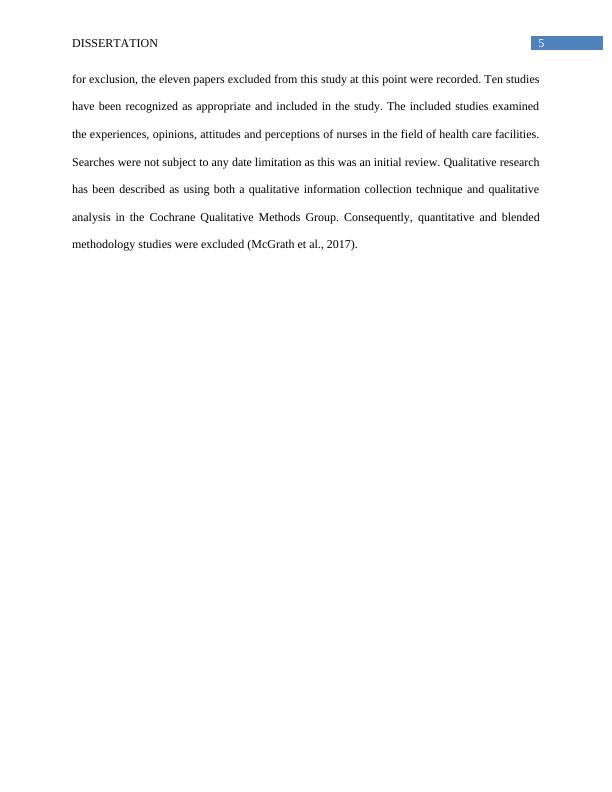
6
Records
identified
through Medline
database
searching
(n = 74)
Records after duplicates removed
(n = 200)
Records screened
(n = 200)
Records screened
(n = 198)
Records excluded
(n = 190)
Records excluded
(n = 186)
Full-text articles
assessed for
eligibility
(n = 10)
Full text articles
excluded, with
reasons
(n = 3)
Full-text articles
excluded, with
reasons
(n = 6)
Included studies in
this investigation
for qualitative
synthesis
(n = 7)
Included
Screening
Eligibility
Identification Records
identified
through Embase
database
searching
(n = 115)
Records
identified
through
PsychInfo
database
searching
(n = 41)
DISSERTATION
Figure 1: PRISMA Diagram for this research investigation
Records
identified
through Medline
database
searching
(n = 74)
Records after duplicates removed
(n = 200)
Records screened
(n = 200)
Records screened
(n = 198)
Records excluded
(n = 190)
Records excluded
(n = 186)
Full-text articles
assessed for
eligibility
(n = 10)
Full text articles
excluded, with
reasons
(n = 3)
Full-text articles
excluded, with
reasons
(n = 6)
Included studies in
this investigation
for qualitative
synthesis
(n = 7)
Included
Screening
Eligibility
Identification Records
identified
through Embase
database
searching
(n = 115)
Records
identified
through
PsychInfo
database
searching
(n = 41)
DISSERTATION
Figure 1: PRISMA Diagram for this research investigation
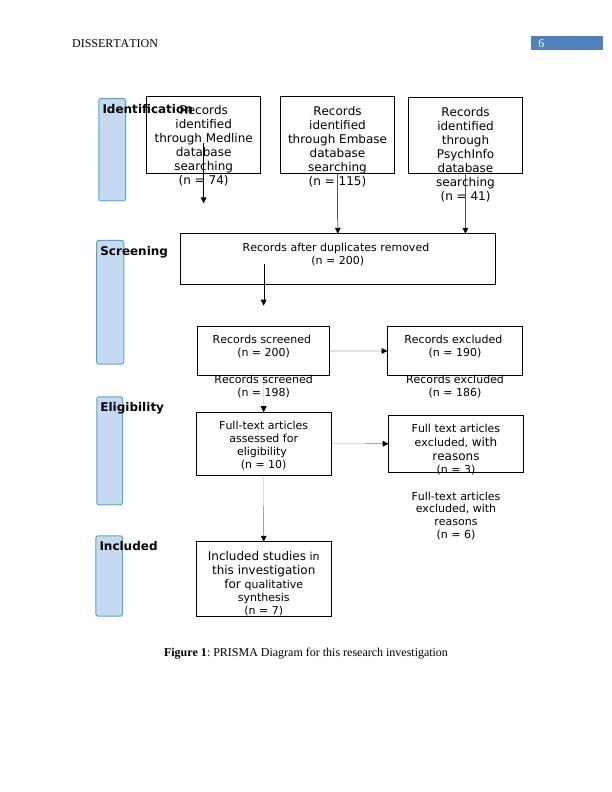
7DISSERTATION
2.3 Search Procedures
Search conditions were initially recognized by extending the question of PICO studies.
Initial pilot tests were carried out to determine if a number of possibly significant researches
could be recorded. In order to determine and form the research question, a systematic review was
carried out using Population, Intervention, Comparison, Result (PICO) methodology for this
review (McGowan et al., 2016). PICO is a very well-developed medical research framework,
which has been selected to assist to develop a defined and restricted issue that will guide the
study process. Databases have been consistently searched for MEDLINE, Embase and PsycInfo
in order to identify studies to incorporate into this research investigation. Use the Boolean
operator search to search for accurate outcomes with important phrases. Only publications of
complete text were recognized and 'Gray literature' was not searched. Searches were not carried
out for the author and quote. The filters and amount of items discovered are identified in a
PRISMA Flow diagram. In addition to these search strategies, a combination of medical topic
headings and keywords was used to tailor these search strategies to three large medical and
nursing databases (Bovid MeDLin, Ovid Mebass).
2.4 Data extraction
Ten appropriate studies were conducted for their features and methodology when the two
databases were searched. Resources, population description, sample size, intervention vs.
comparator, measurements for the results of adherence and authors ' results, and quality are
summarized in a tabular format. For use within the body of the work, the methodology and
results were extracted and the themes were identified and discussed (Norman, Leeflang &
Névéol, 2018). This systematic review investigator has assessed titles and abstracts against the
criteria for incorporation. If a title and an abstract fulfill the inclusion criteria, complete copies of
2.3 Search Procedures
Search conditions were initially recognized by extending the question of PICO studies.
Initial pilot tests were carried out to determine if a number of possibly significant researches
could be recorded. In order to determine and form the research question, a systematic review was
carried out using Population, Intervention, Comparison, Result (PICO) methodology for this
review (McGowan et al., 2016). PICO is a very well-developed medical research framework,
which has been selected to assist to develop a defined and restricted issue that will guide the
study process. Databases have been consistently searched for MEDLINE, Embase and PsycInfo
in order to identify studies to incorporate into this research investigation. Use the Boolean
operator search to search for accurate outcomes with important phrases. Only publications of
complete text were recognized and 'Gray literature' was not searched. Searches were not carried
out for the author and quote. The filters and amount of items discovered are identified in a
PRISMA Flow diagram. In addition to these search strategies, a combination of medical topic
headings and keywords was used to tailor these search strategies to three large medical and
nursing databases (Bovid MeDLin, Ovid Mebass).
2.4 Data extraction
Ten appropriate studies were conducted for their features and methodology when the two
databases were searched. Resources, population description, sample size, intervention vs.
comparator, measurements for the results of adherence and authors ' results, and quality are
summarized in a tabular format. For use within the body of the work, the methodology and
results were extracted and the themes were identified and discussed (Norman, Leeflang &
Névéol, 2018). This systematic review investigator has assessed titles and abstracts against the
criteria for incorporation. If a title and an abstract fulfill the inclusion criteria, complete copies of
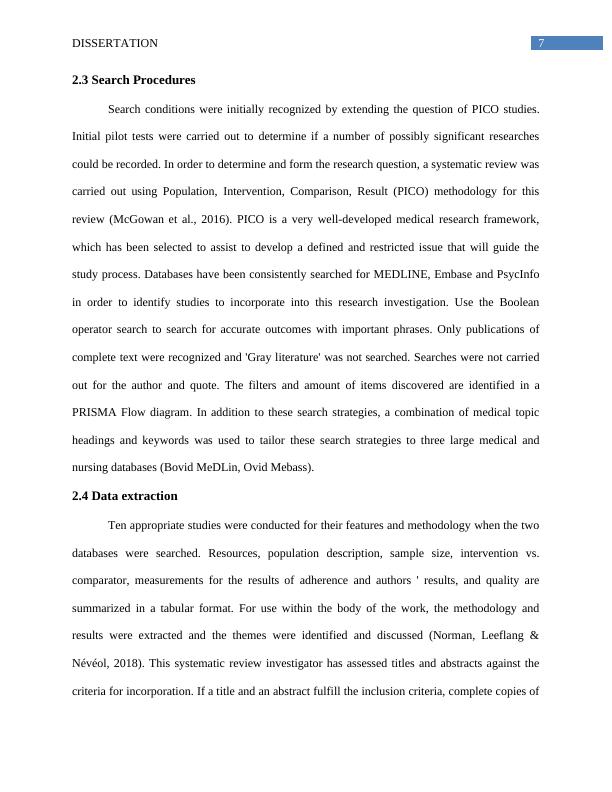
End of preview
Want to access all the pages? Upload your documents or become a member.
Related Documents
Assignment on Effectiveness of School-based Interventions to Preventlg...
|55
|12765
|17
Dissertation on Impact of Socio-cultural Diversity on Leadershiplg...
|56
|14775
|170
Dissertation on Socio-cultural Diversity on Leadershiplg...
|58
|14803
|185
Impact of Socio-cultural Diversity on Leadershiplg...
|58
|15761
|30
Dissertation on Health System (pdf)lg...
|95
|28331
|27
Choline Supplementation for Fetal Alcohol Syndrome in School Childrenlg...
|46
|10556
|454
